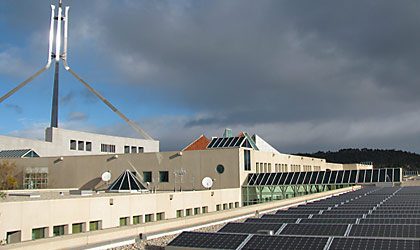Improving the energy efficiency of the federal government buildings could save $35 million a year, a new report by the Green Building Council Australia (GBCA) has found.
The nation’s authority on green buildings delivered its three-point plan for better buildings on Monday, calling on all sides of politics to outline policies to boost productivity in Australian cities and support liveability, community resilience and sustainability – and they think the revolution should start at the top, with federal government-owned buildings.
“Australia’s cities generate 80 per cent of the nation’s GDP and are home to three quarters of our citizens. More productive, sustainable, liveable and resilient cities and communities will deliver a stronger economy and an enhanced lifestyle for all Australians,” said GBCA COO Robin Mellon.
“To position our cities as true powerhouses of productivity, the incoming government must demonstrate visionary leadership. This means ensuring all government-owned, operated and occupied buildings are high-quality and high-performance sustainable buildings.”
According to GBCA, the federal government’s energy consumption equates to almost 1.8m tonnes of carbon and 7.8 m gigajoules of energy per year.
Modelling done by the GBCA found that improving the energy efficiency of the federal government’s building portfolio could save $35 million a year in electricity costs alone.
It also found that, based on the federal government’s current salary costs, a 1 per cent increase in productivity would amount to almost $200 million of benefit a year.
The GBCA has called the government to achieve Green Star ratings for all federally owned buildings to ensure they are efficient, cost-effective and sustainable, to help drive the shift towards better building practices.
The GBCA’s Green Star – Communities rating tool, developed in collaboration with industry and all levels of government, provides best practice benchmarks and metrics across a range of categories that can assist the incoming government to set targets and measure progress.
According to the council, if the government transfers over to the Green Star system they could use up to 66% less energy, emitting 62% fewer carbon emissions.
Retrofitting and improving existing buildings was identified as one of the most cost-effective opportunities for reducing overheads as well as carbon emissions.
GBCA noted that improving energy efficiency was the leading issue as well as reducing water use, employing the use of green building materials, reusing construction waste and reducing red tape around the retrofitting practice.
The GBCA has also been working with the Australian Sustainable Built Environment Council (ASBEC) and a coalition of industry organisations to develop a range of policy solutions which highlight the need to include communities, in a bottom up approach, to improve efficiency.
It says that government must set out clear pathways and benchmarks for improving efficiency and productivity in our communities, to allow progress to be tracked.
Efficiency has been a focus in the building industry of late, as an easy way to save on costs by making smarter moves.
And it’s not only Australia that is highlighting the potential savings in resourceful buildings. A recent article in the Irish Times claimed that the Irish Government could save almost €200m if it adopts energy efficient programs within its buildings.
New York received a surprise this year after some of its 80-year-old municipal buildings out performed some of the city’s’ most energy efficient buildings. Energy savings were uncovered by using the city’s new energy efficiency benchmarking system. Seattle and Washington DC are two more American cities that have also just introduced new benchmarking tools and a focus on efficiency.










